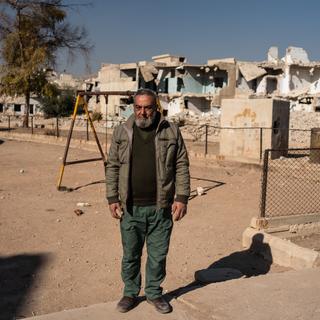


In Damascus, among the ruins of Qaboun, the ghost of community tensions
FeatureThe Syrian capital's Sunni-populated suburb was besieged and bombed for years by government forces, in the name of protecting adjacent neighborhoods inhabited by Alawites, the minority forming the Assad regime's backbone. Today, both communities claim they want to live in peace.
"We wanted to see with our own eyes what was left of our homes. It's unbelievable," deplored Farid al-Atrash, a blacksmith, as he explored the ruins of his family home in the Qaboun neighborhood in mid-December 2024, a few days after the fall of Bashar al-Assad. The eastern flank of the former rebel stronghold, perched on the slopes of Mount Qasioun northeast of Damascus, is now nothing but a tangle of concrete and crushed metal. In this heap of dust, nothing remains, not even steel reinforcing bars, scavenged and sold by scrap dealers under the regime's control.
Like other families wandering these gray mounds of rubble, Farid and his son Abou Fares were treading their land for the first time since 2011. Until the fall of Assad on December 8, 2024, the regime banned residents from returning without special authorization issued by the intelligence services. Yet Abu Fares was born here, in an upstairs room of which only four walls remain, and between which a fig tree has miraculously grown.
"My house is an allegory of the country: a pile of ruins. Bravo, Bashar! Your fall is our greatest victory," rejoiced the 30-something who used to run a small electronics store next door. "We want to move back here. But it will take years and a lot of money to rebuild," he added. Of Qaboun's original 30,000 residents, only a handful remain. "There are barely 2,000 of us left," estimated Yasser Labbat, a 65-year-old grocer whose children fled to Turkey, Libya, Lebanon and Austria. The neighborhood now looks like a ghost town. In the few streets spared total destruction, store shutters remain closed, often torn by shrapnel.
You have 81.41% of this article left to read. The rest is for subscribers only.
